palmistry pdf
Palmistry, or chiromancy, is a mystical practice that analyzes hands to reveal insights into personality, behavior, and potential future events. Rooted in Indian astrology and Roman fortune-telling, it is widely practiced globally.
Modern palmistry focuses on self-discovery and personal growth, offering a guide to understanding character, career, and health, rather than predicting the future. It serves as a tool for self-awareness and empowerment.
1.1 Definition and Overview
Palmistry, or chiromancy, is the ancient art of analyzing hands to gain insights into personality, behavior, and potential future events. It examines palm lines, mounts, and hand shapes to uncover character traits and life themes. This practice, rooted in Indian astrology and Roman fortune-telling, is now used globally for self-discovery and personal growth.
Modern palmistry focuses on understanding oneself rather than predicting the future. It avoids fortune-telling, emphasizing instead the symbolic meaning of hand features to guide self-awareness and decision-making. This holistic approach makes it a popular tool for exploring one’s life path and potential.
1.2 Brief History and Origins
Palmistry, or chiromancy, is an ancient practice with roots in Indian astrology, Chinese divination, and Roman fortune-telling. It dates back thousands of years, with early texts like the Hindu Vedas documenting its use for understanding human destiny.
Over time, palmistry evolved and spread globally, blending with various cultural beliefs. In the West, it became popular in the Middle Ages and was later influenced by Greek and Egyptian traditions. Today, it is used worldwide for self-discovery and character analysis, moving beyond its origins as a predictive tool.
1.3 Purpose and Applications
Palmistry serves as a tool for self-discovery and personal growth, offering insights into character, talents, and potential. It helps individuals understand their strengths and weaknesses, guiding career choices and life decisions.
Practitioners also use palmistry to assess health and emotional well-being, identifying patterns that may indicate physical or mental challenges. This ancient practice encourages self-reflection and empowerment, aiding people in navigating life’s challenges with greater clarity and confidence.
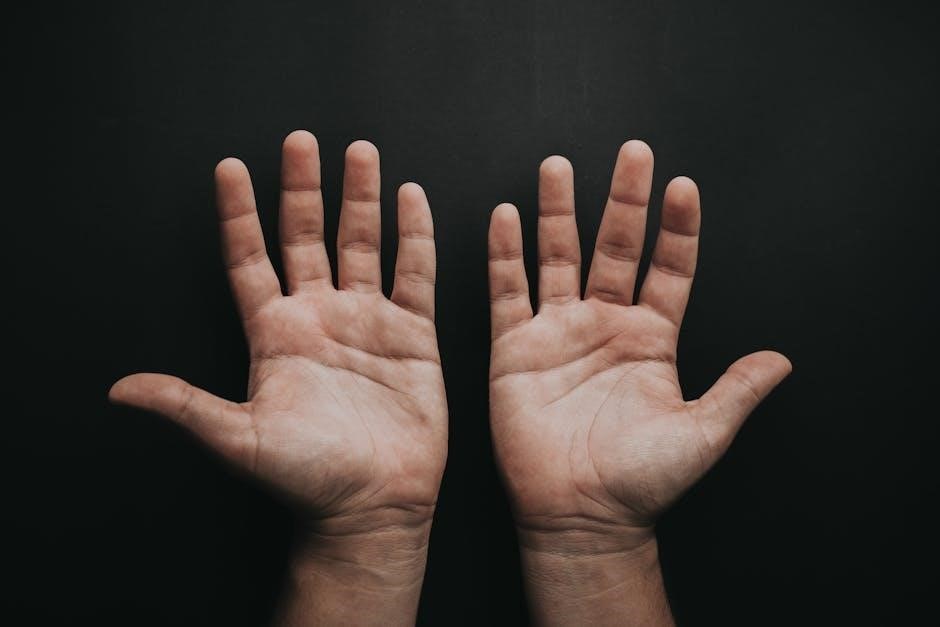
Key Concepts in Palmistry
Palmistry involves analyzing lines, mounts, and hand shapes to uncover insights into personality, talents, and destiny. These elements reveal character traits, emotional tendencies, and life potential, guided by astrological and elemental associations.
2.1 Major Lines: Heart Line, Head Line, Life Line, and Fate Line
The heart line, head line, life line, and fate line are the primary elements in palmistry. The heart line reveals emotional traits and relationships, while the head line indicates intellectual abilities and thought patterns. The life line reflects vitality, resilience, and life journey, though it doesn’t predict death. The fate line, present in some hands, signifies destiny and life’s purpose, offering insights into career and major life events. These lines provide a foundational understanding of an individual’s characteristics and potentials.
2.2 Mounts and Their Astrological Significance
The mounts of the hand, located beneath the fingers, are named after planets and reflect astrological influences. The Mount of Jupiter under the index finger signifies ambition and leadership, while the Mount of Saturn under the middle finger relates to discipline and responsibility. The Mount of Venus, beneath the thumb, governs love and creativity, and the Mount of Mercury under the pinky finger represents communication and intellect. Each mount’s size and shape offers insights into personality traits and life themes.
2.3 Hand Shapes and Their Associated Elements
Hand shapes in palmistry are categorized into four types, each associated with an element: Earth, Air, Water, and Fire. Earth hands are broad with square palms and thick skin, symbolizing practicality. Air hands have long fingers and square palms, representing intellectual traits. Water hands are oval-shaped with long, flexible fingers, linked to emotional depth. Fire hands are rectangular with short fingers, indicating energy and spontaneity. These shapes reveal elemental influences on personality, behavior, and life approaches.
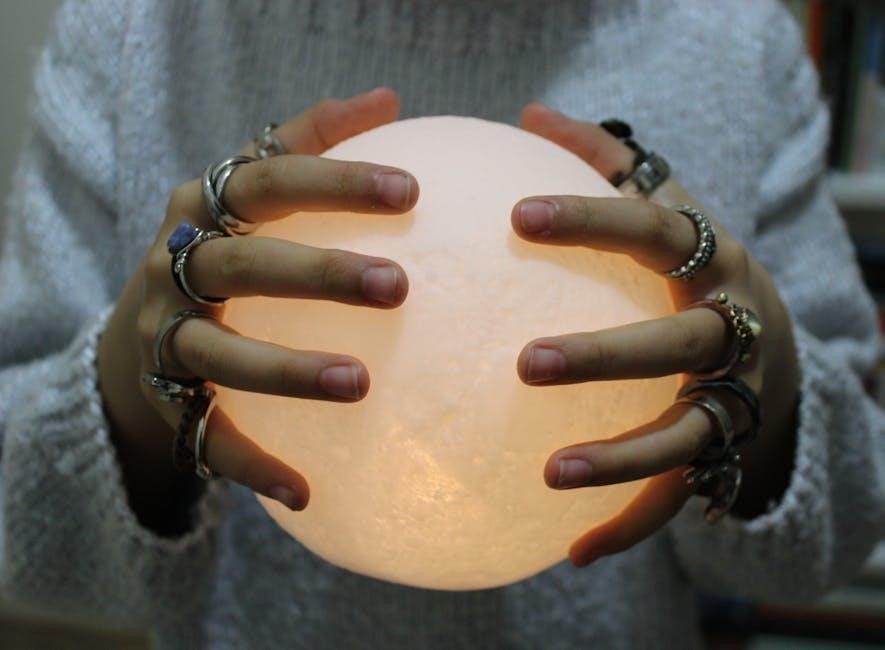
How to Choose the Right Hand for Reading
For women, the right hand reflects life experiences, while the left reveals innate traits. For men, the opposite applies. Dominant hands often symbolize current life, while non-dominant hands may indicate potential or future growth.
3.1 Differences Between Dominant and Non-Dominant Hands
In palmistry, the dominant hand is believed to represent a person’s current life, actions, and conscious decisions. The non-dominant hand, often considered the “birth hand,” reflects innate traits, potential, and subconscious patterns. For women, the right hand is typically dominant, showcasing life experiences, while the left hand reveals natural tendencies. For men, the left hand is often dominant, symbolizing what they were born with, and the right hand indicates how they’ve grown and developed over time. Different schools of thought emphasize that the non-dominant hand can signify future possibilities or untapped abilities, while the dominant hand highlights the present and past actions. This distinction helps palm readers understand both the realized and unrealized aspects of an individual’s life, offering a holistic view of their journey and potential.
3.2 Gender Differences in Hand Selection
In palmistry, gender influences hand selection, with varying interpretations for men and women. For women, the right hand is often seen as reflective of their accumulated life experiences, while the left hand represents innate traits and potential. Conversely, for men, the left hand is typically viewed as indicative of what they were born with, and the right hand highlights their growth and actions over time. This distinction is believed to provide insights into how gender influences the expression of personality, life journey, and potential. Palmists consider these differences to offer a more nuanced understanding of an individual’s characteristics and life path, ensuring a comprehensive analysis that accounts for gender-specific traits and experiences.
3.4 School of Thought on Hand Selection
Different schools of thought exist regarding hand selection in palmistry, with some emphasizing the importance of the dominant hand to reveal current life circumstances and personal growth, while others focus on the non-dominant hand to uncover innate traits and potential. Some believe the left hand signifies what one is born with, and the right hand reflects accumulated experiences. Others argue for a more flexible approach, considering both hands to gain a holistic understanding of an individual’s past, present, and future. This diversity in interpretation highlights the complexity of palmistry.

The Four Major Lines
The four major lines in palmistry are the heart, head, life, and fate lines, each revealing insights into emotions, thoughts, vitality, and destiny, guiding self-discovery.
4.1 Heart Line: Shape, Depth, and Interpretation
The heart line is one of the most significant lines in palmistry, revealing insights into emotional health and relationships. Its shape and depth vary, influencing interpretation.
A deep, clear heart line indicates emotional stability and strong relationships, while a shallow line may suggest emotional vulnerability or instability; Ellen Goldberg notes that lesser-depth heart lines are often referred to as weaker, reflecting potential emotional challenges or a guarded nature.
The heart line’s curvature or straightness also holds meaning. A curved line may indicate a more empathetic and sensitive nature, while a straight line could suggest practicality in emotional matters.
Overall, the heart line serves as a crucial tool for understanding emotional tendencies and relationship patterns, offering deep insights into personal emotional landscapes.
4.2 Head Line: Shape, Depth, and Interpretation
The head line in palmistry reveals mental traits, communication styles, and thinking patterns. Its shape and depth provide insights into cognitive abilities and emotional intelligence.
A straight head line often indicates logical thinking and focus, while a curved line suggests creativity and emotional responsiveness. Depth signifies mental clarity; a deep line shows focus, while a shallow line may indicate mental restlessness or instability.
Breaks or forks in the head line can signify life changes or shifts in mental perspective, offering a deeper understanding of intellectual and emotional adaptability.
4.3 Life Line: Shape, Depth, and Interpretation
The life line is one of the most prominent lines in palmistry, reflecting vitality, energy, and life experiences. Its shape, depth, and length provide insights into emotional resilience and life journey.
A long, curved life line near the thumb suggests emotional strength and family ties, while a short, shallow line may indicate independence or a need for solitude. Breaks or forks in the line can signify major life changes or challenges, offering a deeper understanding of personal growth and adaptability.
4.4 Fate Line: Presence, Absence, and Interpretation
The fate line, often considered optional, reflects career, destiny, and significant life events. Its presence, absence, and clarity offer insights into life’s purpose and challenges.
An absent fate line suggests self-determination, while a strong line indicates a clear path. Breaks or variations may symbolize pivotal changes or transitions, emphasizing adaptability and personal growth in shaping one’s future.
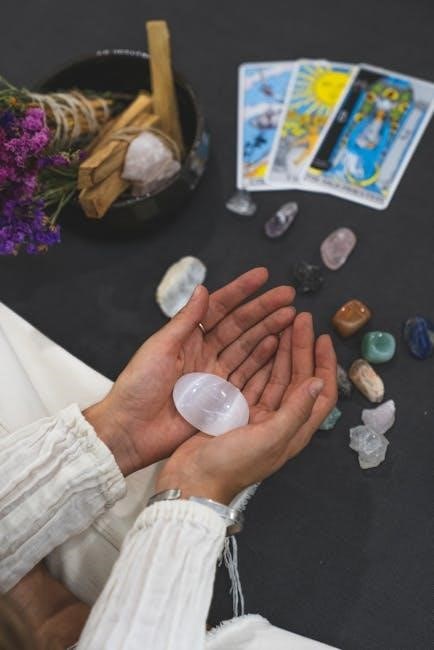
Mounts and Their Astrological Significance
The mounts, fleshy areas under the fingers, correlate with planets and astrological traits, offering insights into personality, career, and life themes, influenced by their prominence and shape.
5.1 Mount of Jupiter: Characteristics and Interpretation
The Mount of Jupiter, located beneath the index finger, reflects ambition, leadership, and confidence. A well-developed mount suggests a dominant, self-assured individual, potentially with a strong desire for power. If prominent, it may indicate a tendency toward self-centeredness or aggression. A lack of development could signify low confidence or a hesitation to take charge. This mount is also linked to personal growth, spirituality, and a philosophical outlook on life, offering insights into one’s aspirations and inner drive.
5.2 Mount of Saturn: Characteristics and Interpretation
The Mount of Saturn, located beneath the middle finger, symbolizes responsibility, discipline, and intuition. A well-developed mount indicates ambition, practicality, and a strong sense of duty. It may also suggest a tendency toward introspection or melancholy. A weak or underdeveloped mount could signify a lack of focus or a carefree attitude. This mount is associated with personal growth, spiritual depth, and the ability to handle life’s challenges with resilience and wisdom.
5.3 Mount of Venus: Characteristics and Interpretation
The Mount of Venus, located beneath the thumb, reflects emotional depth, creativity, and relationships; A prominent mount suggests strong emotional intelligence, passion, and a deep connection to love and art. If well-developed, it indicates a nurturing and empathetic nature, while a less pronounced mount may signify emotional distance or a focus on practicality. This mount is also linked to sensuality and the ability to form meaningful connections, highlighting its role in understanding interpersonal dynamics and emotional well-being.
5;4 Mount of Mercury: Characteristics and Interpretation
The Mount of Mercury, located beneath the pinkie finger, is associated with communication, intellect, and adaptability. A well-developed mount signifies strong verbal skills, creativity, and business acumen, while a less prominent mount may indicate shyness or difficulty expressing ideas. It reflects one’s ability to think critically and navigate social situations effectively. A protruding mount suggests a talkative nature, while a flat or low mount may point to introversion or reserved communication styles, influencing how individuals interact and share their thoughts with others.
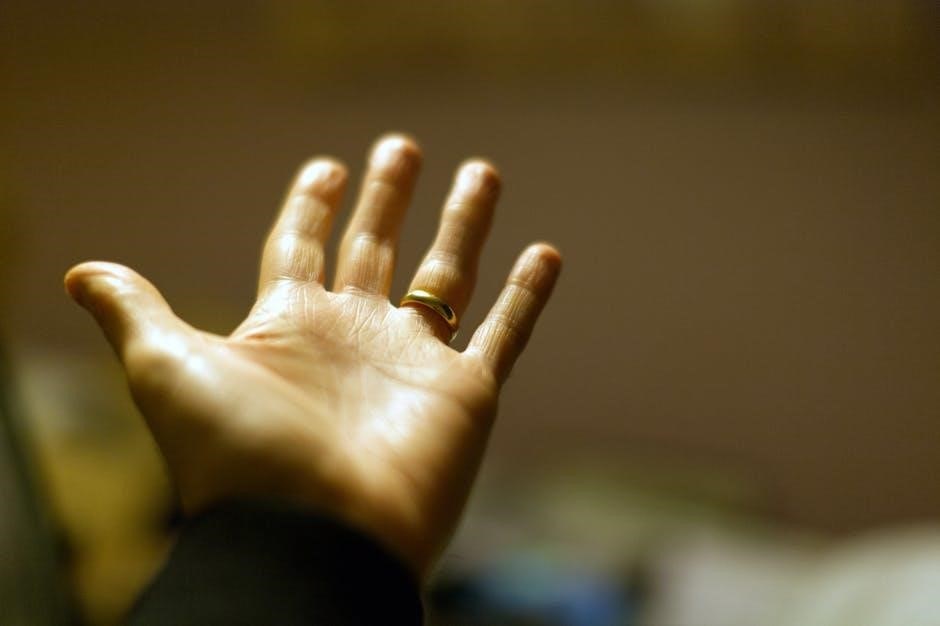
Hand Shapes and Their Elements
Hand shapes are categorized into four types: Earth, Air, Water, and Fire, each linked to specific elements and traits, influencing personality and behavior.
6.1 Earth Hands: Characteristics and Traits
Earth Hands are characterized by broad, square palms and thick, coarse skin, often with a ruddy complexion. They symbolize practicality, responsibility, and solid values. Individuals with Earth Hands are typically grounded, reliable, and hardworking, preferring tangible tasks. Their loyalty and patience make them trustworthy, though they may sometimes appear stubborn or overly materialistic. These hands reflect a connection to the physical world, emphasizing stability and endurance in both personal and professional life.
6.2 Air Hands: Characteristics and Traits
Air Hands are characterized by square or rectangular palms with long fingers, often featuring protruding knuckles and low-set thumbs. The skin is typically dry, and the palm length is shorter than the finger length. Individuals with Air Hands are sociable, talkative, and witty, excelling in mental and intangible tasks. They are innovative and radical in their approaches but can sometimes appear shallow or cold. Their traits align with intellectual pursuits and a love for communication, making them naturally adaptable and curious about new ideas and perspectives.
6.3 Water Hands: Characteristics and Traits
Water Hands are identified by their long, oval-shaped palms and flexible, conical fingers. The palm length equals the finger length but is narrower. Individuals with Water Hands are creative, perceptive, and empathetic, often possessing strong intuition. They tend to be introverted, preferring quiet, intuitive actions. While they are emotionally deep and sensitive, they can also be moody or inhibited. Their traits reflect a balance of emotional depth and reserved nature, making them compassionate and insightful in their approach to life and relationships.
6.4 Fire Hands: Characteristics and Traits
Fire Hands are characterized by square or rectangular palms with shorter fingers and flushed or pink skin. The palm length exceeds the finger length, indicating spontaneity and enthusiasm. Individuals with Fire Hands are optimistic, passionate, and extroverted, often acting boldly and instinctively. While they can be egoistic or impulsive, their vibrant energy drives them to pursue goals with determination. Fire Hands reflect a dynamic, adventurous spirit, making their owners natural leaders with a flair for taking risks and embracing challenges wholeheartedly.

Advanced Topics in Palmistry
Advanced palmistry explores medical palmistry, identifying health indicators, and combining palmistry with astrology for deeper insights. Rare hand lines and their unique interpretations are also examined in detail.
7.1 Medical Palmistry: Health Indicators in the Hands
Medical palmistry examines hand features to detect health issues. Lines, mounts, and skin texture reveal potential ailments. For instance, a broken or fragmented life line may indicate health crises or chronic conditions. The presence of certain markings can signal genetic predispositions, while finger length and nail health provide insights into vitality and immune strength. This practice, while not a substitute for medical diagnosis, offers a complementary tool for early detection and wellness management.
7.2 Palmistry and Astrology: Combined Insights
Palmistry and astrology intersect by associating hand features with planetary influences. Mounts under fingers correspond to zodiac signs, revealing character traits and life themes. For example, the Mount of Jupiter links to leadership and ambition, while the Mount of Venus reflects emotional and relational tendencies. This blend offers deeper insights into personality, strengths, and weaknesses, aligning palmistry with astrological profiles to enhance self-understanding and guide life decisions.
7.3 Rare Hand Lines and Their Meanings
Rare hand lines, such as the Fate Line or unusual markings, hold unique significance. The absence of a Fate Line suggests self-determination, while its presence may indicate life-changing events. Other rare lines, like the Intuition Line, are linked to heightened sensitivity or psychic abilities. Medical palmistry identifies health indicators, such as breaks or islands in lines, which may signal past or potential health issues. These rare features provide deeper insights into an individual’s life journey, personality, and potential challenges.
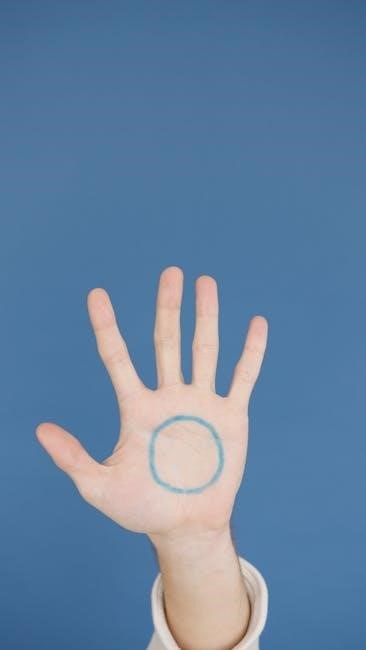
Palmistry and Relationships
Palmistry reveals insights into romantic and familial connections through love lines, marriage lines, and children lines. These markings offer clues about relationship dynamics, potential partners, and family life.
8.1 Marriage Lines: Location and Interpretation
Marriage lines are small horizontal lines located under the little finger, near the edge of the palm. Their depth, length, and number provide insights into romantic relationships. Deeper, longer lines suggest stable, long-lasting marriages, while faint or fragmented lines may indicate shorter or less stable relationships. Some palmists believe these lines can signify the number of marriages or significant partnerships, though interpretations vary. These lines are thought to appear or deepen as relationships develop, offering a symbolic glimpse into one’s romantic life.
8.2 Children Lines: Location and Interpretation
Children lines are vertical lines found below the marriage lines, near the base of the little finger. Their presence and characteristics are believed to indicate the number and gender of children. Deeper, broader lines often suggest male children, while fainter, narrower lines may indicate female children. Palmists interpret these lines to provide insights into family planning and potential parenthood, though their accuracy is not scientifically validated and should be viewed as symbolic rather than definitive predictions.
8.3 Love Lines: Location and Interpretation
Love lines, also known as marriage or relationship lines, are small horizontal lines located above the heart line, near the base of the little finger. Their depth, length, and number are interpreted to assess romantic relationships. Deeper lines suggest stronger, longer-lasting connections, while faint or fragmented lines may indicate shorter or less stable relationships. Palmists believe these lines offer insights into love life, though interpretations vary and should be approached with a symbolic perspective rather than as certainties.

Practical Applications of Palmistry
Palmistry serves as a tool for self-discovery, career guidance, and health insights, offering a holistic approach to understanding personality, life choices, and personal growth through hand analysis.
9.1 Palmistry as a Tool for Self-Discovery
Palmistry offers a profound method for self-discovery, enabling individuals to gain insights into their personality, strengths, and weaknesses. By analyzing hand lines and mounts, one can uncover latent potential, emotional tendencies, and life purpose, fostering personal growth and self-awareness.
It serves as a mirror to the soul, helping individuals understand their inner world and outer experiences. This ancient practice encourages introspection, allowing people to align their actions with their true nature and aspirations, promoting a harmonious and fulfilling life.
9.2 Palmistry in Career and Life Choices
Palmistry provides valuable insights for career and life decisions by revealing innate strengths, talents, and personality traits. The analysis of hand lines and mounts helps identify professional inclinations, guiding individuals toward fulfilling career paths. For instance, a prominent Mount of Jupiter may indicate leadership potential, while a well-defined Mercury mount suggests strong communication skills. This ancient practice empowers individuals to align their career choices with their natural abilities, fostering job satisfaction and personal growth. It serves as a compass for making informed, purpose-driven life decisions.
9.3 Palmistry for Health and Wellness
Palmistry offers insights into health and wellness by analyzing hand features. The life line reveals energy levels and vitality, while finger lengths and nail shapes indicate health traits. For example, short fingers may suggest impatience, potentially linked to stress-related issues; The Mount of Saturn is associated with health challenges, such as chronic illnesses. Palmistry helps identify potential health risks, aiding in early prevention and wellness strategies. It serves as a complementary tool for understanding physical and mental well-being, promoting holistic health management.
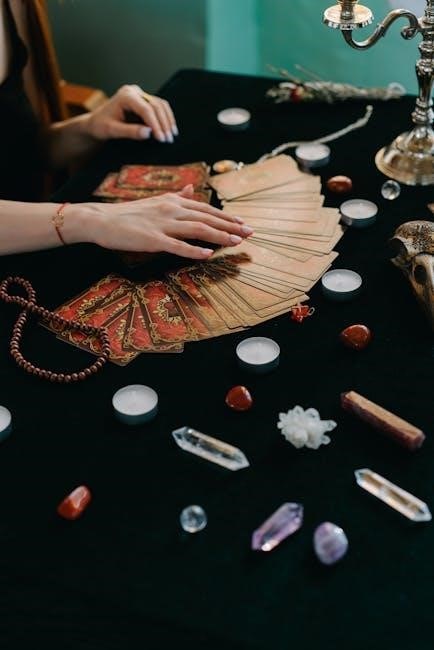
Resources for Learning Palmistry
Discover comprehensive guides like “The Art and Science of Hand Reading” and online courses offering in-depth tutorials. Notable experts share insights, aiding learners in mastering palmistry effectively.
10.1 Recommended Books on Palmistry
For a deeper understanding, explore books like The Art and Science of Hand Reading by Ellen Goldberg, offering classical methods for self-discovery. Chiero’s works provide foundational knowledge, while B.V. Raman’s books blend astrology with palmistry insights. 50 Case Studies in Modern Palmistry is ideal for practical learning through real-life examples. These resources are essential for beginners and advanced practitioners, ensuring a comprehensive understanding of palmistry techniques and interpretations.
10.2 Online Courses and Tutorials
Explore online courses and tutorials to master palmistry techniques. Platforms like Udemy and Coursera offer courses on hand analysis, medical palmistry, and astrological connections. Notable instructors include Ellen Goldberg and Jennifer McVey, who provide in-depth lessons. These resources often include video tutorials, interactive quizzes, and downloadable materials. Whether you’re a beginner or looking to refine your skills, online courses offer flexible learning opportunities to deepen your understanding of palmistry and its practical applications.
10.3 Notable Palmistry Experts and Their Contributions
Renowned palmistry experts like Ellen Goldberg and Jennifer McVey have significantly contributed to the field. Goldberg co-authored ‘The Art and Science of Hand Reading,’ blending traditional methods with modern insights. McVey, a spiritualist with over 22 years of experience, specializes in manifesting and life coaching through palmistry. Their work emphasizes palmistry’s role in self-discovery and personal growth, making it accessible to contemporary practitioners. Their contributions have enriched the practice, offering deeper understanding and practical applications of this ancient art.
Palmistry, while rooted in ancient traditions, offers modern insights into self-discovery and personal growth. It serves as a symbolic guide, encouraging introspection and empowerment, without predicting destiny.
11.1 Final Thoughts on Palmistry
Palmistry is a timeless practice blending tradition and modern insights, offering a unique lens for self-discovery and personal growth. It emphasizes understanding character, career, and health, guiding individuals toward empowerment without dictating their future. By focusing on symbolic interpretations, it encourages introspection and self-awareness, making it a valuable tool for those seeking deeper insights into their lives and potential. Its adaptability ensures its relevance in contemporary times, appealing to both spiritual seekers and curious learners alike.
11.2 Encouragement to Explore Palmistry Further
Embrace the fascinating world of palmistry to deepen your understanding of yourself and others. With its rich history and modern applications, it offers a versatile tool for self-discovery and personal growth. Whether you seek insights into character, career, or health, palmistry provides a unique perspective. Explore books, online courses, and expert guidance to enhance your knowledge. This ancient practice, rooted in tradition, continues to evolve, making it accessible to anyone curious about its potential. Dive in and uncover the hidden stories your hands hold.